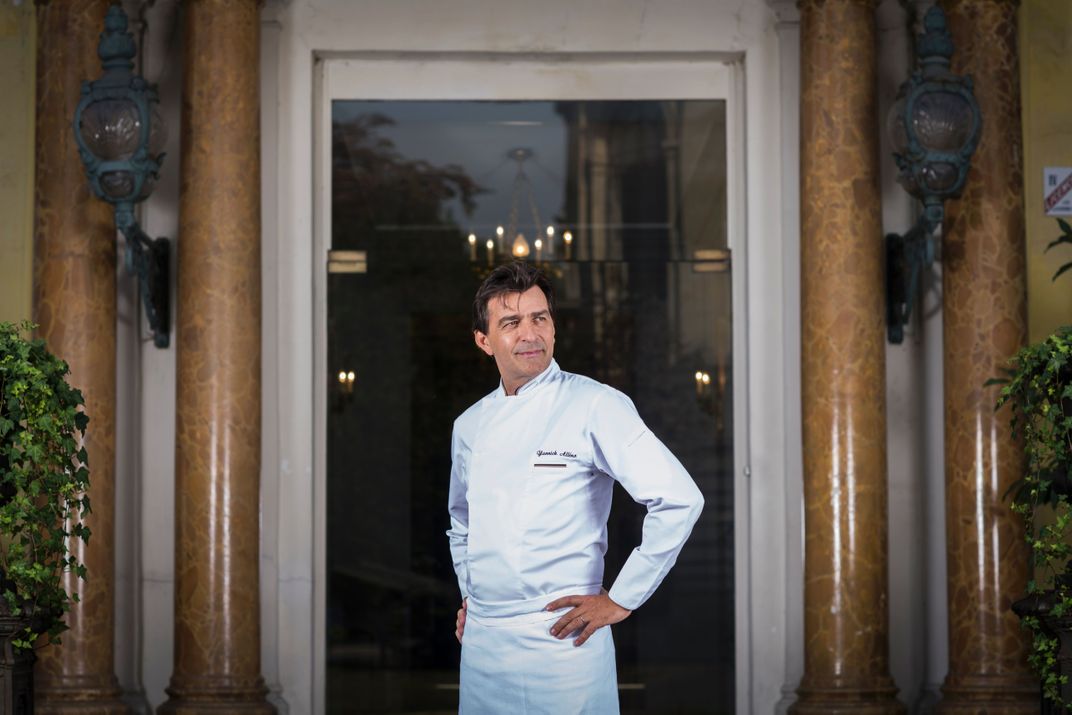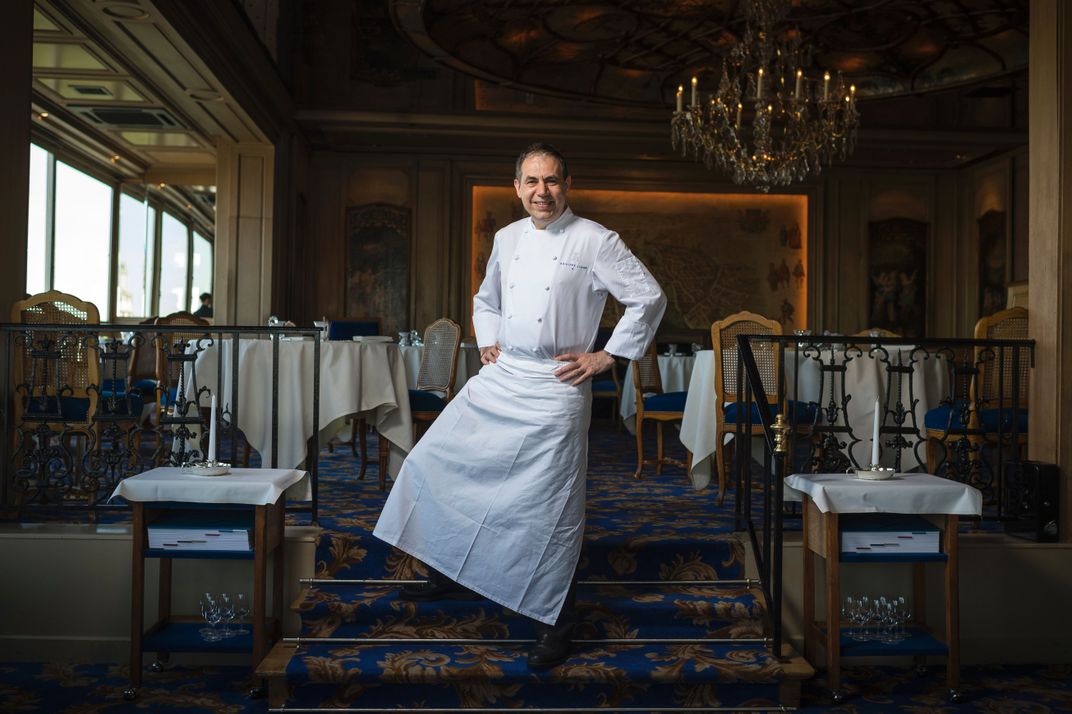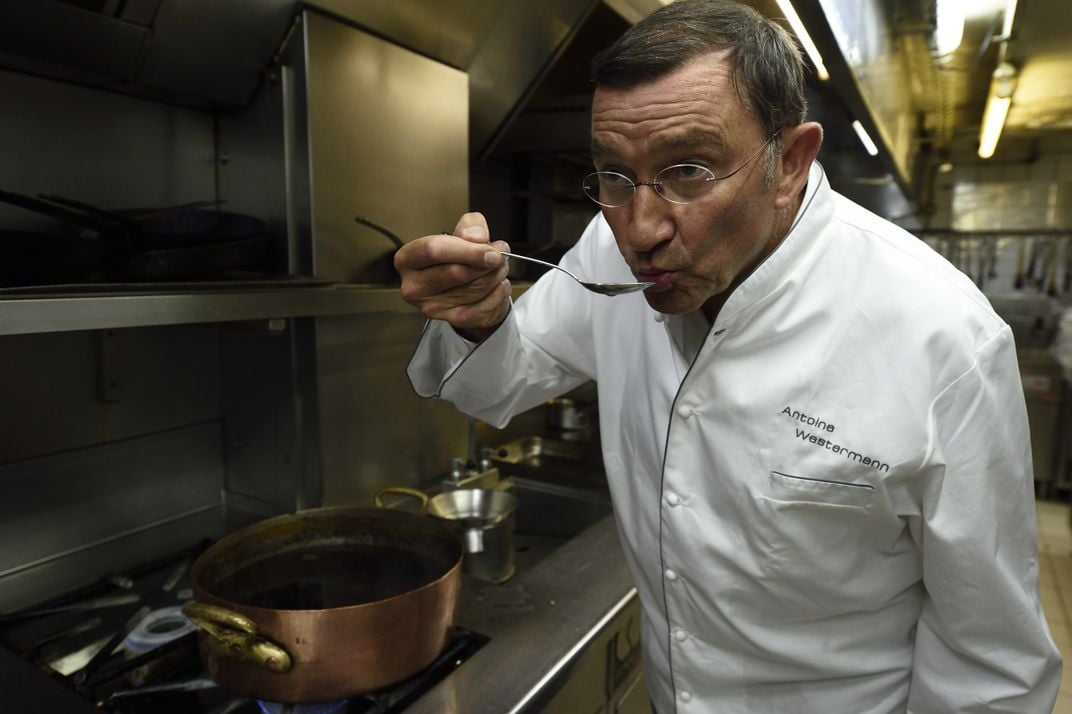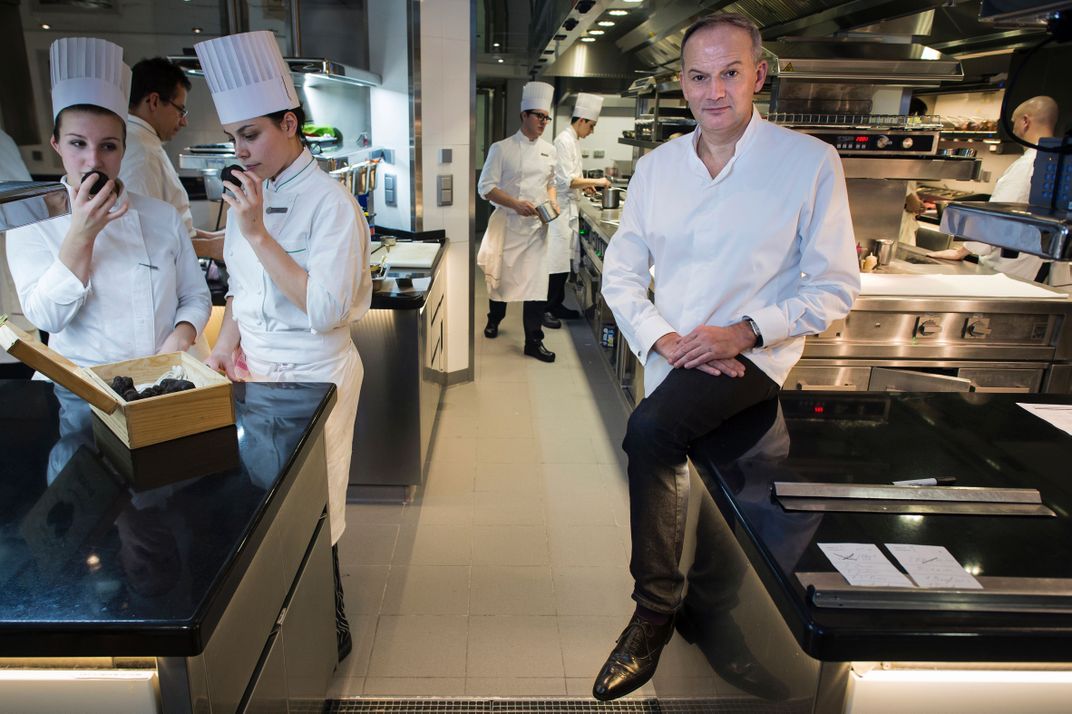Does the Classic Paris Meal Still Exist?
Two food lovers set out to learn whether the Paris dining experience of their youth can still be found
/https://tf-cmsv2-smithsonianmag-media.s3.amazonaws.com/filer/c2/bd/c2bd3f0b-18ed-4e1f-8cbb-0dde4ea342c1/sqj_1701_aoe_paris_01.jpg)
It happened in MontMartre. One quiet afternoon, on a cobblestone street where Toulouse-Lautrec, Utrillo, and Picasso once trod, an oil painting caught our eye in the window of Galerie Roussard, one of the oldest, most famous art galleries on the Butte. The dream-like restaurant scene featured indistinct black-suited waiters in long, white aprons passing among tables draped in red cloths, a bottle of wine on one, a carafe of water on another. It evoked a long-vanished era, a moment frozen in time.
“Impressive, isn’t it?” The question startled us. We looked up to see the bearded but youthful face of the gallery owner, Julien Roussard, who then invited us inside. Up close, the painting came alive, waiters scurrying from table to table bearing steaming bowls of pot-au-feu and platters of roast chicken. A napkin tucked under his chin, a diner tore apart what looked like a lobster. At another table, a man and woman held hands, their food ignored on the table before them.
“Bouillon Chartier,” noted Roussard, “is still a working restaurant,” first opening in 1896 and now classified a monument historique. “Nothing has changed there in the last hundred years, and nothing is likely to change in the next hundred.”
The painting by Serbian artist Marko Stupar took us back to those exhilarating days in the fall of 1978 when we first arrived in Paris and Don took a post as a foreign correspondent for CBS News. Nothing then disappointed us: The Eiffel Tower, houseboats and barges on the River Seine, the Cathedral of Notre Dame, and the majestic Champs-Élysées were just as we had imagined. But it was the restaurants that truly dazzled us. We’d heard, of course, so much about the glories of French cuisine, but nothing had prepared us for the experience. We plunged into the dining scene with unending appetites, worshipping at such temples of haute cuisine as La Tour d’Argent, Ledoyen, and Taillevent, but not forgetting either to pay tribute to the smaller, more modest cafés and restaurants. We were hooked.
In France, eating has traditionally been something more than satisfying hunger pangs. “A profound love of great food and wine has always permeated French society and the country’s identity,” says Alexander Lobrano, author of Hungry for Paris: The Ultimate Guide to the City’s 109 Best Restaurants, one of the most thoughtful guide-books currently available. “The French phrase les arts de vivre (the arts of living) includes good cooking and conveys the deep seriousness with which the French shop, cook, and consume food. They talk and think about it constantly.” Stupar’s painting articulated les arts de vivre perfectly. The motion and energy of a restaurant, the color, taste, and texture of the food, and the care with which it was prepared. The celebration and sensuousness of the act of eating.
But the painting also reminded us how Paris restaurants have changed over the years since our first visit. And in many cases for the worse. Certainly we had become more selective if not more finicky with age: Now authors of a couple of books on wine and veterans of 35 years living in the city, we were no longer ingénues. Eating in Paris had become for us an expensive, often disappointing trial. We had grown tired of having to call weeks or months in advance for reservations. Prices had skyrocketed. The proprietors of small, cozy places, whom we’d come to know as good friends, had retired or passed away. In time, we drifted away too.
But that painting of Bouillon Chartier had tantalized us with thoughts of lost pleasures. When a friend compared our habit of not eating out in Paris to visiting the Louvre and not seeing the “Mona Lisa,” we knew that something had to change.
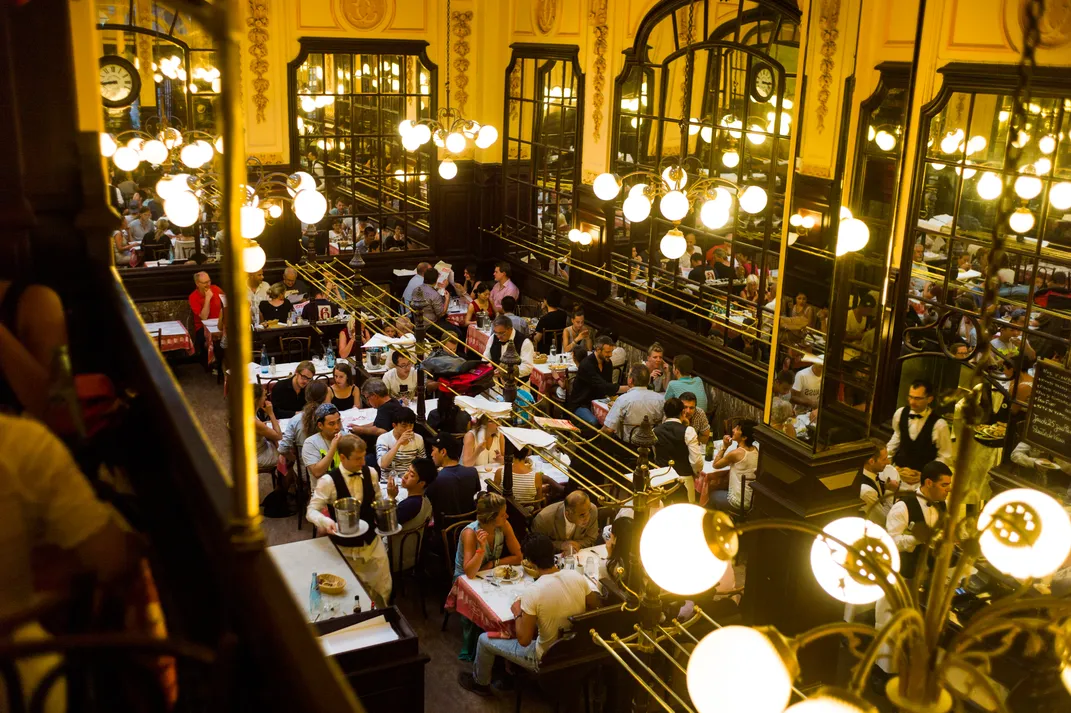
But where to start? Much like a first-time visitor, we felt lost and confused. We dusted off our trusty red Michelin, albeit out of date, but how could it compete now with the stack of much newer guidebooks, slew of blogs, and dozens of Internet crowd-sourced sites? We decided to start with a few places we remembered from the old days.
First stop, Val d’Isère. As the first place we ate when we arrived in Paris, it was our sentimental favorite. Just off the Champs-Élysées, near the Arc de Triomphe, the charming, old-fashioned brasserie featured ancient wooden skis on the walls along with photographs of ski champions of yesteryear. The same waiters always served and took great care of us. Aside from the plat du jour, the menu never changed. Val d’Isère felt eternal.
To our dismay, we found that it wasn’t: Val d’Isère had been transformed into an African-themed bar called the Impala Lounge. We couldn’t bear to go inside.
We then approached Jamin, which we remembered as a simple, yet elegant, small restaurant—not far from the apartment we first lived in near Place du Trocadéro—that the equine-loving owner had decorated with engravings of famous horses. Since our first visit in 1978, ownership had changed, with the restaurant at one point becoming the home of celebrated chef Joël Robuchon, who had earned his third Michelin star there.
Much to our relief, Jamin had reverted to its more humble roots as a solid neighborhood restaurant, serving delicious food in a relaxed, warm, and friendly atmosphere. Don’s delicately grilled coquilles Saint-Jacques (scallops) were served on a bed of crème de poireaux (leeks), while Petie’s cannelloni aux légumes (vegetable cannelloni) was surprisingly rich and bursting with flavor.
Now, feeling more confident, we returned to La Tour d’Argent, where we had enjoyed one of the most spectacular meals of our lives. Seated at a table overlooking the Seine and the Cathedral of Notre Dame, we had celebrated our 25th anniversary, gorging ourselves on foie gras, scrambled eggs with truffles, and roast duckling, all washed down with glasses of champagne and a sublime bottle of Burgundy.
On the way to our table, we passed photographs of patrons that included kings, queens, and movie stars. Nothing seemed to have changed.
But the magic had faded. The restaurant had shed two of its coveted three Michelin stars and taken harsh criticism in the press. Lobrano believes many high-end restaurants have lost their way and become distant and patronizing. “The rites and rules of traditional three-star dining weren’t making people happy anymore,” he told us. “Prices had become astronomical, and everything was too formal.”
A chef who once worked at La Tour d’Argent agreed. “Before the current problems, gastronomic restaurants were lively places, jovial places for enjoying yourself. But then we created museums—that’s what went wrong—museums with heavy atmosphere. People want warmth. We have to make everything lighter, including the bill.”
Yet despite these dire observations, there’s never been a better or more exciting time to eat in Paris. “In the last ten years, there’s been a pretty spectacular renewal of the Paris landscape,” says Lobrano, who has eaten in more Paris restaurants than practically anyone else. “A new generation of really talented young chefs has created a new type of bistro. That’s where the best eating is in Paris today.”
Parisians call it bistronomie, from the mashing together of bistro and gastronomie. Whereas bistros traditionally featured limited menus and a casual dining environment, bistronomie boasts a range of rich, inventive dishes, often reflective of globalizing forces. New chefs are coming from Spain, Scandinavia, Japan, Australia, and the United States. Antoine Westermann, who earned three stars at a restaurant in Alsace and now runs Mon Vieil Ami, summed up the bistro world when he told us, “My goal is not to impress but to bring out emotion, like a nice soup, a really nice soup, so nice that you can’t remember when you last had the same.”
Four years ago the American couple Braden Perkins and Laura Adrian opened Verjus, a restaurant and wine bar near the Palais-Royal in the heart of Paris. “It’s been exciting to discover French products for the first time and to be cooking with them,” Perkins says. “It’s thrilling to be in the kitchen.”
But it didn’t start out that way. “Center of Paris Under Attack by Americans!” screamed one French headline. Today it’s much different. Most of the French press now raves about their cooking, and that of other foreign chefs as well.
“There’s a real brotherhood among the guy and gal chefs in Paris,” says Wendy Lyn, creator of The Paris Kitchen, a website that serves as the true insider’s guide to the culinary scene. “They are very open and welcoming.”
Now even the French chefs, many of whom had left the country after becoming disillusioned with the stultifying traditions, are returning, armed with new ideas and more experience. “French cooks are excited to be cooking in their own country again,” Perkins said. “They are thrilled to be doing something different.”
We asked Westermann whether Paris still stands at the epicenter of world-class cuisine.
“No, no,” he responded vigorously. “It was, but it isn’t now. To a large extent, French cuisine has become world cuisine.” He challenged us to go to another country, close our eyes while eating, and try to identify where we are. “You can eat fabulously in so many different places.”
Still, it came as a shock when the New York Times last year reported that a hefty percentage of French restaurants relied on ready-made meals produced offsite in large industrial kitchens. “Can Anyone Save French Food?” the paper asked.
The primary reason for the reliance on mass-produced food appears to come from diminishing profit margins brought about by new labor laws, which cut work hours to 35 a week. The article deeply embarrassed France’s culinary establishment. Soon afterward, authorities launched a promotional campaign encouraging restaurants that prepare food on the premises to display a fait maison, or house-made, label.
But when most of the country’s restaurants turned up their noses at the program, the government quickly dropped it and said it would try something else. The “kerfuffle” over industrial kitchens has not, says Lebrano, “impinged on the quality of French food.” Paris is still the ultimate destination for those seeking that classic meal. “I don’t think there’s a pyramidal hegemony of dominance in the realm of gastronomy anymore, but France remains the ultimate gastronomic reference.” Top among the reasons are the country’s extraordinary produce and rigorous system of culinary education, as well as the presence of a food-educated public with a keen interest in good food.
Still, the question we dread the most when a friend comes to France is “Where should I go for a classic French meal?” We tossed that question to Lyn, who advises many Paris restaurants and leads food tours for professionals and private individuals. She laughed. “It’s all about expectations,” she said. “Recommending a restaurant is almost like setting up a blind date. You hope it works out.”
While bistros may claim much of the inventive energy now in Paris cuisine, the high-end restaurants should not be written off. “A three-star is not the experience people are looking for in the way they used to,” Lyn points out. “People were hit in the wallet too hard, but I think the creativity is still there.”
In restaurants like Le Cinq and Ledoyen, new young chefs have taken over, bringing a creative and provocative flair to high cuisine. It’s still possible to come to Paris and enjoy that blowout, once-in-a-lifetime experience of fabulous food, presented with great service in elegant surroundings.
For that kind of meal, we like Epicure, a chic, discreet restaurant that focuses on traditional French haute cuisine, in the renowned Bristol Hotel. “It’s the hardest level to cook at,” says chef Eric Frechon, “because at its best, all of its complexity should be invisible.”
But most of the time we find ourselves these days at bistros. Top on our list is Le Grand Pan, a neighborhood spot advertising cuisine sans chichis, a meat-lover’s paradise. Our marvelous côte de boeuf pour deux (rib steak) was enough to feed an entire rugby squad.
We are also fond of Mon Vieil Ami, Westermann’s little bistro on Île Saint-Louis. Vegetarians can eat well there (and carnivores too). One of us had paupiettes de veau with fricassée de légumes (stuffed veal with vegetable fricassee); the other ordered velouté de potiron and risotto aux épinards et champignons (a pumpkin soup with spinach and mushroom risotto). Both dishes elicited sighs of pleasure. Other bistros drawing rave notices include Paul Bert, Akrame, Le Chateaubriand, Frenchie, and Septime.
In our journey through Parisian cuisine, we had, of course, one place we had to visit: the restaurant in that painting, Bouillon Chartier. Gallery owner Roussard offered to call the artist and arrange a lunch there. “It’s the best I can do, because Marko won’t sell the painting. He’s decided he wants to keep it for himself.”
Stupar, a 79-year-old who sported a ponytail and a Vandyke, had captured the place beautifully, down to the waiters in black vests and white aprons pirouetting expertly among the tables, writing orders on the paper tablecloths. Complimentary glasses of champagne arrived at our table. As the waiter turned around, he knocked a glass into Stupar’s lap. Before we could blink, a replacement sat in front of him and a thick wad of napkins appeared to soak up the spill. Stupar laughed as he dabbed at his shirt. “I’m glad I wasn’t sketching.” The hubbub, happy diners in animated conversations, the waiters moving too quickly among tables crowded closely together—they were all part of the dining experience.
The food? Let us put it this way. The restaurant is a place where atmosphere is truly everything.
